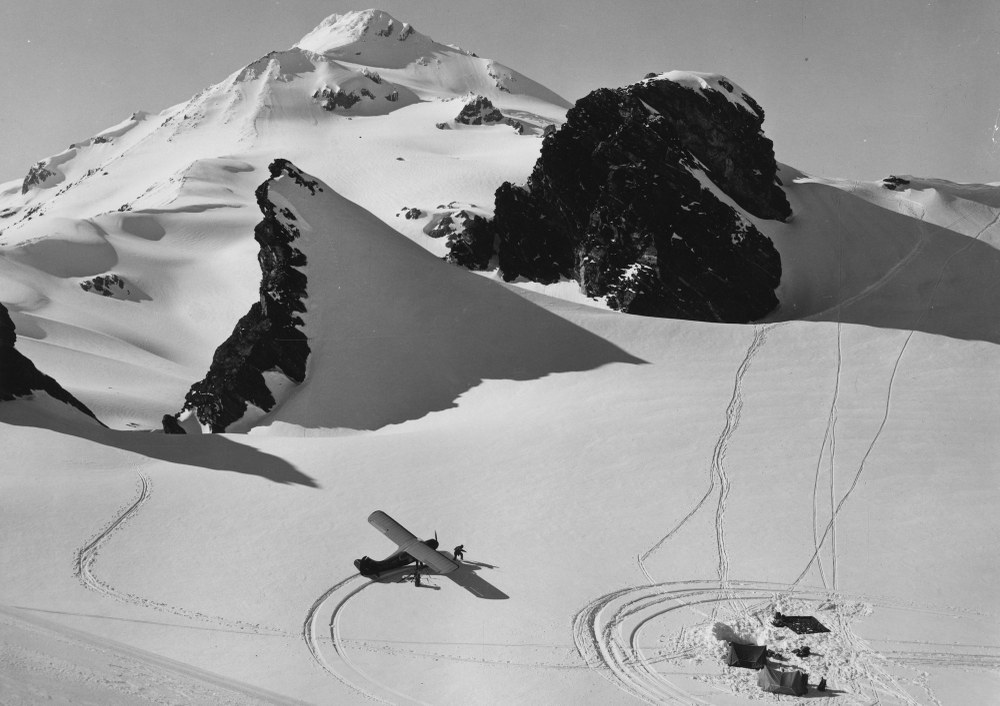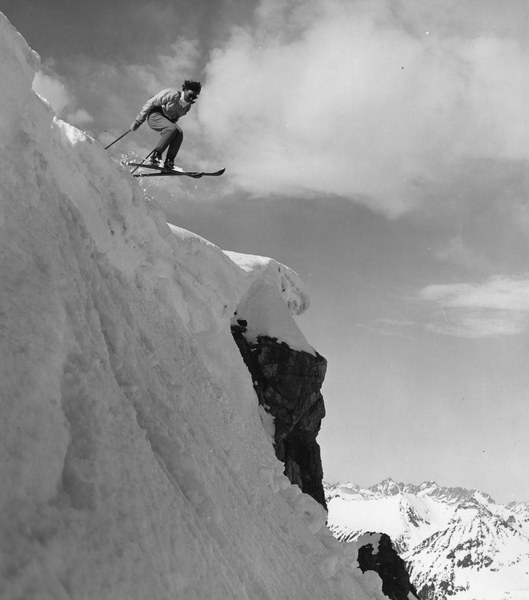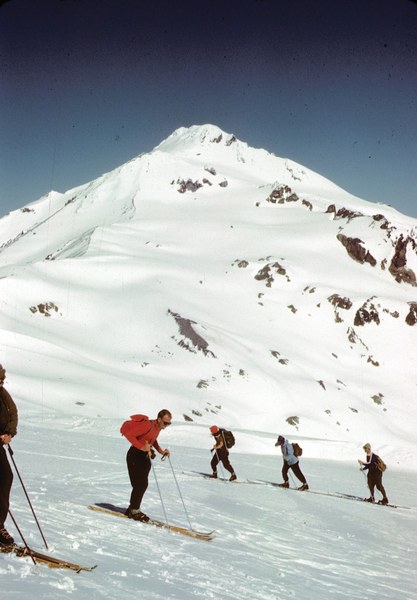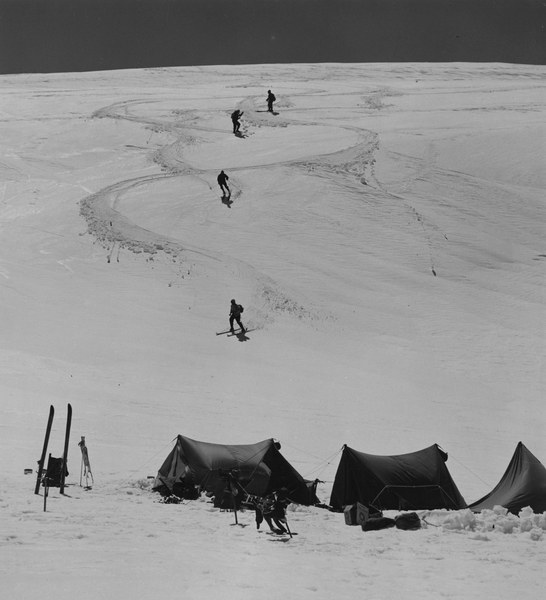
In May of 1959, a party of ten Mountaineers were flown one at a time from Darrington Airstrip to a 7,800-foot camp on Glacier Peak. Local photographer Ira Spring organized and led the party of six men and three women to join the expedition, one of his many enterprising invitations to bring people together through photography and adventure. The trip took these Mountaineers six unforgettable days.
Piloted by Port Angeles pilot Bill Fairchild, the plane was a two-place Aronca Champ, equipped with wheels and retractable skis – an unusual feature for the time – that made it capable of landing and taking off on hard ground as well as snow. To assuage the party’s skepticism at this novel mode of travel, Ira volunteered for the first flight. It took the pilot ten hours to get everyone to the glacier. Each passenger was tasked with reloading the plane with gear and more fuel.
Gary Rose was one of the ten who were flown from Darrington Airport to the Honeycomb Glacier. Gary had been on several trips to the mountains with Ira, so he was pleased when Ira asked him to go on a new expedition. Although he had climbed Glacier twice, he had never flown in an airplane with skis to land on a glacier. The prospect was an exciting one.
Other party members included Keith Gunnar, another talented photographer, Stella Degenhardt, widow of a former Mountaineers President and a cheerful skier and climber regardless of conditions, and John and Irene Muelemans, who became engaged on the trip and would later gain recognition for their long-distance backpacking, climbing, and skiing trips.
 Female skier jumping off ledge, UW42256.
Female skier jumping off ledge, UW42256.
Exploring Glacier Peak
Once on Honeycomb Glacier, the picture taking began. With clear weather, the climbers posed for Ira for two days. Shots included cooking around camp, setting up sleep equipment, and exploring the surrounding terrain. The group looked like they had flown to the moon, surrounded by never-ending peaks of white.
On the third day, a blue-sky weather window allowed the group to embark on their climb. They got an early start for the summit. Equipped with skis, climbing skins, ice axes, crampons, and climbing ropes, the group slogged upward for seven hours. Their mountaineering skis were hickory wood and the skins were mohair military surplus.
The ascent itself was uneventful, smooth and sunny. They reached the summit around noon and enjoyed wonderful views in all directions. From Puget Sound to Lake Wenatchee and up to the Canadian border and down to Mt. Adams, the sweeping vistas extended. In the distance below, grey clouds could be seen developing. A front was coming in from the west.
During the 3,000-foot descent to camp, the skiers were greeted with untracked powder snow. A few took some headers and face plants on the way down, but the fresh powder was forgiving. They felt they were floating down the long slope.
 Climbing Glacier Peak. Photo by Gary Rose.
Climbing Glacier Peak. Photo by Gary Rose.
Singing, skiing, and soaking
The next day, Ira and Keith took advantage of the last favorable lighting to get a few more shots. Gary and Dave – skiing, backpacking, and climbing friends – were tasked with tackling Tiger Tower, a rock pinnacle near camp. Their route, while harrowing at times, made for grandiose images of the rugged rock outcrop with Glacier Peak looming in the background at 10,436 feet.
That night, the ten party members crowded into one four-person tent for dinner and singing. One of the participants, Stella Degenhardt, loved to sing, and led the climber's chorus. Tent seams were strained as party members shared in joy and laughter.
The next morning, the weather front finally reached camp. The crew packed up and left in deteriorating weather, cloudy and cool. They managed to lift their enormous packs and start downward on their skis. As they reached the valley floor, the snowbanks thinned. Hours went by and it began to rain.
Traveling through the snowbanks and heavy brush was exhausting and slow going on skis. When the group reached creeks and streams, they found no easy way across and had to either climb upward through slide alder or seek a fallen log to cross creeks.
There was no trail, so the group found their way by relying on USGS maps and compass alone. They descended the Whitechuck Glacier and followed the Whitechuck River. On the second day of their exit, they reached Kennedy Hot Springs, a small wooden tub next to the river filled with warm, muddy water.
With only enough room for four people at a time, everyone took turns in the hot springs. The women claimed the first turn to soak and only yielded to the men when they were bombarded with snowballs. When the soaking was over, the group was desperate for clean and dry clothes, which they didn’t have. What’s worse, they discovered that among all party members, they only had one towel for the party. Dirty t-shirts had to make do.
The group camped one final night, leaving the next morning to ski out the last six miles to the waiting cars. Their superb Glacier Peak ski expedition was over.
 Skiing down Honeycomb Glacier, UW42255.
Skiing down Honeycomb Glacier, UW42255.
Preserved in history
Such a trip is not possible today. Not only is Glacier Peak now in Wilderness prohibitive of motorized plane travel, but the glaciers have receded and, in some areas, disappeared. Rockslides have replaced the long expanses of new snow the skiers once enjoyed, and Kennedy Hot Springs has been buried by a land slide.
These ten Mountaineers were lucky to have seen what they did: expansive glacial landscapes, aerial views of Glacier’s wilderness, soothing riverside hot springs. Thanks to Ira’s photos, we can imagine what it must have been like to see it all, too.
This article is written by Gary Rose with Joan Burton.
This article originally appeared in our summer 2024 issue of Mountaineer magazine. To view the original article in magazine form and read more stories from our publication, visit our magazine archive.
 Gary Rose
Gary Rose